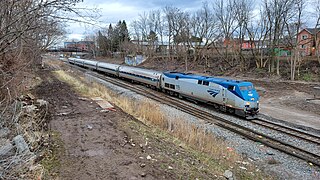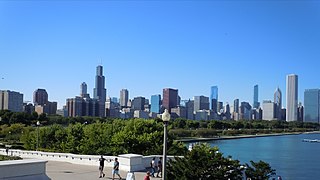
The Maple Leaf is an international passenger train service operated by Amtrak and Via Rail between New York Penn Station in New York City and Union Station in Toronto via Amtrak's Empire Corridor, and the south western part of Via Rail's Quebec City–Windsor Corridor. Daily service is offered in both directions; the 544-mile (875 km) trip takes approximately 12 hours, including two hours for U.S. or Canadian customs and immigration inspection at either Niagara Falls, New York, or Niagara Falls, Ontario. Although the train uses Amtrak rolling stock exclusively, the train is operated by Via Rail crews while in Canada and by Amtrak crews in the United States. Service began in 1981.

The New York Central Railroad was a railroad primarily operating in the Great Lakes and Mid-Atlantic regions of the United States. The railroad primarily connected greater New York and Boston in the east with Chicago and St. Louis in the Midwest, along with the intermediate cities of Albany, Buffalo, Cleveland, Cincinnati, Detroit, Rochester and Syracuse. New York Central was headquartered in New York City's New York Central Building, adjacent to its largest station, Grand Central Terminal.

The Empire Service is an inter-city rail service operated by Amtrak within the state of New York in the United States. The brand name originated with the New York Central Railroad in 1967. Trains on the line provide frequent daily service along the 460-mile (740 km) Empire Corridor between New York City and Niagara Falls via Albany, the state capital.

The Lake Shore Limited is an overnight passenger train operated by Amtrak between Chicago and the Northeastern United States, with sections to New York City and Boston. The central segment of the route runs along the southern shore of Lake Erie. East of Chicago, the Lake Shore Limited follows the former main line of the Lake Shore and Michigan Southern Railway to South Bend, Toledo, Cleveland, and Buffalo. From here the train takes the Empire Corridor through Rochester and Syracuse to Albany–Rensselaer station in Rensselaer, New York. At that station, the train divides, with one section continuing to Springfield and Boston in Massachusetts, while the other continues along the Empire Corridor to New York City. The train is scheduled for 19+1⁄2–20+1⁄4 hours for the 959 miles (1,543 km) between Chicago and New York, and 21+1⁄2–22 hours for the 1,018 miles (1,638 km) between Chicago and Boston.

Michigan Services are three Amtrak passenger rail routes connecting Chicago, Illinois with the Michigan cities of Grand Rapids, Port Huron, and Pontiac, and stations en route. The group falls under the Amtrak Midwest brand and is a component of the Midwest Regional Rail Initiative.

The Boston and Albany Railroad was a railroad connecting Boston, Massachusetts to Albany, New York, later becoming part of the New York Central Railroad system, Conrail, and CSX Transportation. The mainline is currently used by CSX for freight as the Berkshire Subdivision and Boston Subdivision. Passenger service is provided on the line by Amtrak, as part of their Lake Shore Limited service, and by the MBTA Commuter Rail system, which owns the section east of Worcester and operates it as its Framingham/Worcester Line.

The Michigan Central Railroad was originally chartered in 1832 to establish rail service between Detroit, Michigan, and St. Joseph, Michigan. The railroad later operated in the states of Michigan, Indiana, and Illinois in the United States and the province of Ontario in Canada. After about 1867 the railroad was controlled by the New York Central Railroad, which later became part of Penn Central and then Conrail. After the 1998 Conrail breakup, Norfolk Southern Railway now owns much of the former Michigan Central trackage.

Niagara Falls station is an international railway station in Niagara Falls, Ontario, Canada. It is served by the Maple Leaf train between Toronto and New York City and is the terminus of GO Transit's Lakeshore West line towards Toronto. The Gothic Revival station building, which was built in 1879 by the Great Western Railway, is a designated heritage railway station. It is also listed on the Canadian Register of Historic Places.

The Empire State Express was one of the named passenger trains and onetime flagship of the New York Central & Hudson River Railroad. On September 14, 1891, it covered the 436 miles (702 kilometers) between New York City and Buffalo in 7 hours and 6 minutes, averaging 61.4 miles-per-hour (98.8 km/h), with a top speed of 82 mph (132 km/h).

Buffalo–Depew station is an Amtrak train station in Depew, New York, a suburb of Buffalo. It was built in 1979 to replace the Buffalo Central Terminal as Buffalo's main Amtrak station. It is located 10 miles (16 km) east of downtown Buffalo.

The International was a named passenger train operated between Chicago and Toronto. It was originally an overnight train operated by the Grand Trunk Railway of Canada and its successors the Canadian National Railway and Grand Trunk Western Railroad, running as far as Montreal. The train was cut back to Port Huron, Michigan, in 1970 and discontinued in 1971.

The Wolverine is a higher-speed passenger train service operated by Amtrak as part of its Michigan Services. The 304-mile (489 km) line provides three daily round-trips between Chicago and Pontiac, Michigan, via Ann Arbor and Detroit. It carries a heritage train name descended from the New York Central Railroad.

The Great Lakes megalopolis consists of a bi-national group of metropolitan areas in North America largely in the Great Lakes region. It extends from the Midwestern United States in the south and west to western Pennsylvania and Western New York in the east and northward through Southern Ontario into southwestern Quebec in Canada. It is the most populated and largest megalopolis in North America.

Windsor station is a train station in Windsor, Ontario, Canada. It is the western terminus of Via Rail's Quebec City–Windsor Corridor. It is located in the Walkerville neighbourhood adjacent to the Hiram Walker distillery, near the Detroit River. During the week, it is served by eight Via Rail train trips per day, of which 4 originate in Windsor and 4 return to Windsor from Toronto. In 2012, Windsor was listed as the seventh busiest station in the country, according to Via.

The Twilight Limited was a named passenger train in the United States which initially operated between Chicago, Illinois, and Detroit, Michigan. The New York Central Railroad introduced the train in 1926, and it continued until the formation of Amtrak in 1971, although it lost its name in 1967. Amtrak renamed the train St. Clair, feeling that the name "Twilight Limited" had undesirable connotations and imagery for a company trying to save passenger rail service. Amtrak revived the name in 1976 for a new train frequency on the Chicago–Detroit corridor, and kept the name until all trains on that corridor were renamed Wolverine in 2004.

The Canada Southern Railway Station (CASO) is a former railway station in St. Thomas, Ontario, Canada. The station was built by the Canada Southern Railway (CSR) in 1873 as both a railway station and its corporate headquarters. It was one of the busiest stations in Canada during the 1920s. Train traffic ceased in the 1980s.

Windsor was a train station in Windsor, Ontario, Canada. The station was built by the Michigan Central Railroad in 1911 and subsequently controlled by the Canada Southern Railway. The station served Canada Southern Railway and New York Central trains. Windsor also has another railroad station in town.
The Wolverine was an international night train that twice crossed the Canada–United States border, going from New York City to Chicago. This New York Central Railroad train went northwest of Buffalo, New York, into Canada, traveled over Michigan Central Railroad tracks, through Windsor, Ontario, reentering the United States, through Detroit's Michigan Central Station, and on to Chicago. At the post-World War II peak of long-distance named trains, there were three other New York Central trains making this unusual itinerary through Southwestern Ontario. In the late 1960s, this was the last remaining train taking this route, failing to survive into the Penn Central era. The name resurfaced on the truncated Detroit–Chicago route with Amtrak's Wolverine.
Fort Erie was a pair of adjacent Grand Trunk and Michigan Central railroad stations in Fort Erie, Ontario. In earlier years, the Wabash Railroad served the Grand Trunk station as well via traffic rights.
The Canadian and later, Canadian-Niagara, was the longest running named international train from Chicago to Upper Canada via Detroit, for its first two decades running to Montreal. This overnight train was operated by the Michigan Central Railroad from Chicago to Detroit, and in a pool arrangement, it operated over Canadian Pacific Railway tracks and used the same train number from Detroit eastward. The train would carry a second section, bound, variously for Buffalo or New York City via Buffalo.


















